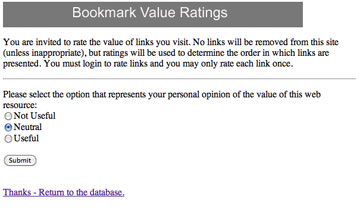I have my own social bookmarking site I have built from an early version of Scuttle. I liked Scuttle, but wanted a system that would prioritize links based on a system of use and rated value. More popular and valued links would appear at the top. As a bookmarking system grows and becomes complicated you need a way to tap into others for assistance. Just going through all of the links to see which still function would take hours. The value rating (the checkmarks) allows others to help. Rate a site as “not useful” and I will eventually take a look.
One problem in creating a system that is built on participant contributions is that you will soon encounter spammers and worse. So, I created a login system that allowed authentication. I encountered the problem that Scuttle already had a simple login system so I had a login system protecting a login system. It was a mess and too complicated for all but the most hardy.

I have finally had the time to work on the site. I have modified the login system so that only one login is now required. My site is certainly not as polished as Diigo or Delicious, but it has a specific focus and it improves with the activity of those who participate.

15 total views


 ]
]
You must be logged in to post a comment.